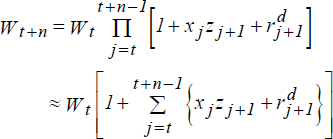RDP 9307: Explaining Forward Discount Bias: Is it Anchoring? Appendix E: Comparing the Traders' Performance
June 1993
- Download the Paper 119KB
Starting with real wealth, Wt, in period t and choosing new portfolio allocations each period, a trader's real wealth in period t + n is, from equation (B1),
since
 « 1 for all j. Using our first-order
Taylor expansions for xj and zj+1 (equations
(9)
and (B7)), the difference between the anchored and rational traders'
real wealth after n periods is
« 1 for all j. Using our first-order
Taylor expansions for xj and zj+1 (equations
(9)
and (B7)), the difference between the anchored and rational traders'
real wealth after n periods is
Evaluating ( )Δsj+1
and recognising that
Z(α,n) ≡ (
)Δsj+1
and recognising that
Z(α,n) ≡ ( )/Wt leads to equation
(15) in the
text.[32]
)/Wt leads to equation
(15) in the
text.[32]
Footnote
The Krugman (1981) refinement discussed in the previous footnote adds extra terms
to both xj and zj+1. The extra terms in xj cancel
when the difference
 is formed. The (small) extra term
in zj+1
is (1/2 – g)(Δsj+1)2. Over the range of
possible values for g (0 ≤ g ≤ 1) we have established empirically that
this extra term makes negligible difference to the only quantity we care
about: p(α,n) ≡ Pr[Z(α,n) > 0]. Note finally that all
these extra terms are zero when foreign and domestic goods enter equally
in the traders' consumption basket, i.e., when g = 1/2.
[32]
is formed. The (small) extra term
in zj+1
is (1/2 – g)(Δsj+1)2. Over the range of
possible values for g (0 ≤ g ≤ 1) we have established empirically that
this extra term makes negligible difference to the only quantity we care
about: p(α,n) ≡ Pr[Z(α,n) > 0]. Note finally that all
these extra terms are zero when foreign and domestic goods enter equally
in the traders' consumption basket, i.e., when g = 1/2.
[32]

